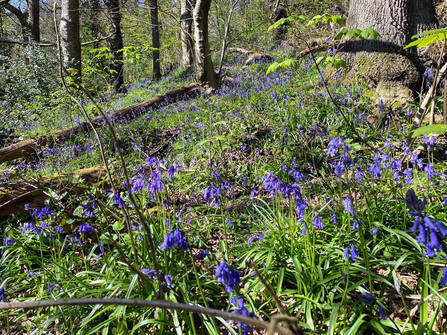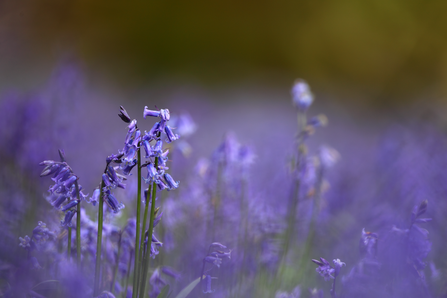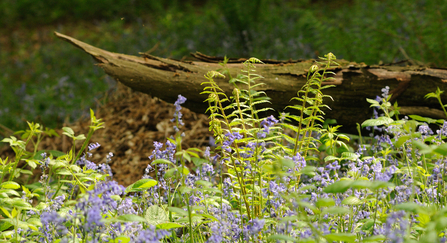The UK is home to more than half of the world's population of bluebells. They truly are the celebrities of our spring woodlands. Their presence attracts numerous species of pollinators and invertebrates which are vital for a blooming spring. Bluebells are easily identifiable, just look for long, narrow, drooping leaf fronds, and bending flower stems that are heavy with nodding, blue bell-shaped flowers. However, it's not just the colour which make this iconic flower so appealing, it's also its unique subtle sweet scent which only adds to their decadent demeanour.
Best bluebell walks in Lancashire, Manchester and North Merseyside
Katrina Martin / 2020VISION
The bluebell's Latin name, Hyacinthoides non-scripta, comes from ancient Greek mythology. When the prince Hyacinthus died, the tears of the god Apollo spelled the word 'alas' on the petals of the hyacinth flower that sprang up from his blood. Non-scripta means unlettered and distinguishes the bluebell from the similar-looking hyacinth.
The plant spends most of the year as a bulb emerging from April onwards. This early flowering allows it to make the most of the woodland sunshine, before the full leaf canopy appears overhead.
So where are the best bluebell walks in Lancashire, Manchester and North Merseyside?

Matt Swift
Boilton Woods, Preston
A stunning carpet of blue can be seen amassing the woodland floor in April and May making it the best time to go and visit to see the amazing bluebells. Boilton Woods are part of one of the longest and biggest stretches of ancient woodland in the whole of Lancashire making them even more special.
The woodlands run alongside the river Ribble, a sight itself with its glistening water and calming flow, and makes for one of the best bluebell walks in spring. The woodland can be accessed through our Brockholes nature reserve, so you could finish your walk with a visit to our unique floating visitor village for a tasty lunch or cup of coffee and a cake.

Bluebells (c) Luke Massey/2020VISION
Aughton Woods, Lancaster
Aughton Wood's location means an escape from the outside world. Its tranquil and serene sights alluding to that of a renaissance painting and is an inspiration to nature lovers and poets alike. A visit in spring is sure to overwhelm you with its beautiful azure blaze of bluebells that produce a radiant glow under the spring sunshine. A sight surely not to be missed.
Along with the bluebells, primroses, opposite-leaved golden saxifrage, wood speedwell and foxgloves all grow in Aughton Woods, with the only sounds being that of the native bird's songs which include chiffchaffs, chaffinches and five species of tit, as they glide from tree to tree, making this a remarkable spring walk.
Warton Crag, Lancaster
In spring the woods at Warton Crag are an awash with those much-loved dangling blue heads erupting from the ground. These bulbs can conjure in their millions in just one wood giving rise to the famous ‘blue carpets’ which are a springtime delight.
The wildflowers too are a sight behold. The colours of wood anemone, primrose, early purple orchids, violets and pignut are particularly spectacular when sunlight sprinkles its golden rays on the woodland floor.
Such flourishing flora and unique habitats mean Warton Crag is a paradise for some of Britain’s rarest butterflies. These include the pearl-bordered fritillary (along with the more widespread but none-the-less wonderful small pearl-bordered fritillary), which both start to emerge in spring.

WildNet - Amy Lewis
Cross Hill Quarry, Clitheroe
Wildlife and wildflowers have reclaimed this former quarry. The mixture of woodland and small meadows provide a refuge for wildlife, and is also home to the incredible bluebell - just one the species found amongst the wildflowers, culminating in blue swathes across the woodlands.
Small skipper, orange-tip and meadow brown butterflies flutter through the decadent grasslands, where the nearby River Ribble makes for a picturesque backdrop. The mosaic of the meadows is not only beautiful but most of the paths are wheelchair user friendly allowing for this painting of spring beauty to be enjoyed by all. In spring blackcaps, willow warblers and chiffchaffs can all be heard playing a cacophony of melodies, whereas when night falls Daubenton’s bats skim insects form the river's surface making for a serene sight.
Bluebells are one of our favourite sights of spring, heralding warmer days to come and starting the annual explosion of wildlife. Here at The Lancashire Wildlife Trust we are working hard to care for our precious woodlands, and all of the nature and people that rely on them.

